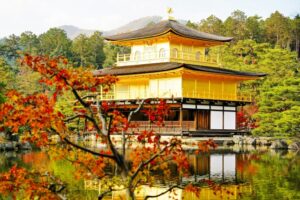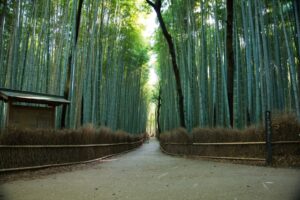“Kyoto: Where Japan’s Ancient Traditions Come Alive”
Introduction:
Kyoto, Japan’s ancient capital, is a city where the past comes alive in every corner. Steeped in history and culture, Kyoto offers visitors a chance to experience Japan’s traditional arts, beautiful temples, and serene gardens. For those seeking a true connection with Japan’s heritage, Kyoto is the place to be.
Historical Significance of Kyoto:

Kyoto was Japan’s capital for over 1,000 years, from 794 until 1868. This long history has deeply influenced the city’s cultural and spiritual landscape. With over 2,000 temples, shrines, and historical landmarks, Kyoto is often regarded as the spiritual heart of Japan. It is home to several UNESCO World Heritage Sites, including the famous Kinkaku-ji (Golden Pavilion), Fushimi Inari-taisha, and Kiyomizu-dera, each a symbol of Japan’s rich cultural traditions.
One of Kyoto’s most iconic locations is Kinkaku-ji, a Zen Buddhist temple covered in gold leaf, set against a beautiful backdrop of trees and a serene pond. The peaceful surroundings invite reflection, making it a must-see for visitors interested in both Japan’s architectural beauty and spiritual heritage. Similarly, Fushimi Inari-taisha, with its thousands of red torii gates that wind up the mountainside, offers an unforgettable experience. The hike to the summit, surrounded by these striking gates, is both a spiritual journey and a stunning natural experience.
Kyoto’s Cultural Highlights:

Kyoto is famous for its deep-rooted cultural experiences. The traditional tea ceremony, a centuries-old ritual, is one of the most famous cultural practices in Japan. Kyoto has many tea houses where you can experience this art, which emphasizes harmony, respect, purity, and tranquility. For a truly authentic experience, visiting a traditional ryokan (Japanese inn) where the tea ceremony is held can give you insight into the refined simplicity of this ritual.
Gion, the historic geisha district, is another highlight of Kyoto’s cultural scene. Walking through its cobblestone streets, visitors can glimpse geisha and maiko (apprentices) dressed in colorful kimonos, making their way to appointments. You can also take part in cultural experiences such as learning the delicate art of flower arranging (ikebana) or the traditional Japanese performance art of kabuki.
Kyoto’s Seasonal Beauty:

Kyoto’s beauty shifts dramatically with the seasons, providing a unique experience depending on when you visit. Spring brings an explosion of cherry blossoms, and the Philosopher’s Path, a tree-lined canal, becomes a popular spot for cherry blossom viewing. In the autumn months, the city transforms into a landscape of vibrant colors, with the Tofuku-ji Temple and Arashiyama Bamboo Grove offering some of the best views of the autumn leaves. Kyoto’s gardens are also a delight throughout the year, with meticulously maintained landscapes designed to create harmony with nature.
Kyoto’s Culinary Traditions:

Kyoto is known for its refined cuisine, which emphasizes seasonal ingredients and delicate flavors. Kaiseki, a multi-course meal that features the freshest seasonal ingredients, is one of Kyoto’s culinary highlights. This dining experience is a celebration of the changing seasons, with each dish beautifully presented and prepared with the utmost care. Traditional Kyoto cuisine also includes yudofu (tofu hot pot), a dish that highlights Kyoto’s rich tofu culture, and matcha-based sweets, which are made from the region’s famous green tea.
Conclusion:

Kyoto offers a rare opportunity to experience Japan’s cultural heart. From ancient temples to tea ceremonies, seasonal beauty, and traditional cuisine, Kyoto allows visitors to immerse themselves in the timeless traditions that have shaped Japan’s history. Whether you’re exploring its temples or enjoying a traditional meal, Kyoto is the perfect destination for those who want to connect with the essence of Japan’s rich cultural heritage.
